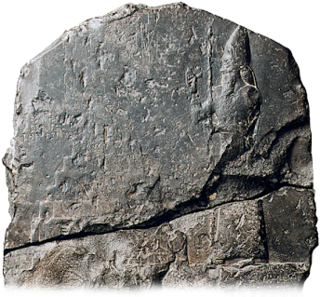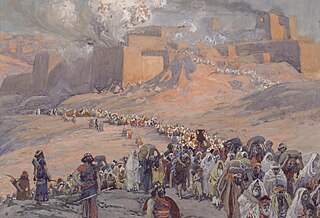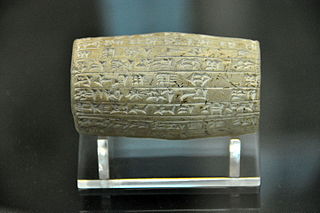Related Research Articles

Chaldea was a small country that existed between the late 10th or early 9th and mid-6th centuries BC, after which the country and its people were absorbed and assimilated into the indigenous population of Babylonia. Semitic-speaking, it was located in the marshy land of the far southeastern corner of Mesopotamia and briefly came to rule Babylon. The Hebrew Bible uses the term כשדים (Kaśdim) and this is translated as Chaldaeans in the Greek Old Testament, although there is some dispute as to whether Kasdim in fact means Chaldean or refers to the south Mesopotamian Kaldu.

Babylonia was an ancient Akkadian-speaking state and cultural area based in the city of Babylon in central-southern Mesopotamia. It emerged as an Amorite-ruled state c. 1894 BC. During the reign of Hammurabi and afterwards, Babylonia was called "the country of Akkad", a deliberate archaism in reference to the previous glory of the Akkadian Empire. It was often involved in rivalry with the older ethno-linguistically related state of Assyria in the north of Mesopotamia and Elam to the east in Ancient Iran. Babylonia briefly became the major power in the region after Hammurabi created a short-lived empire, succeeding the earlier Akkadian Empire, Third Dynasty of Ur, and Old Assyrian Empire. The Babylonian Empire rapidly fell apart after the death of Hammurabi and reverted to a small kingdom centered around the city of Babylon.

Nebuchadnezzar II, also spelled Nebuchadrezzar II, was the second Neo-Babylonian emperor, ruling from the death of his father Nabopolassar in 605 BC to his own death in 562 BC. Historically known as Nebuchadnezzar the Great, he is typically regarded as the empire's greatest king. Nebuchadnezzar remains famous for his military campaigns in the Levant, for his construction projects in his capital, Babylon, including the Hanging Gardens of Babylon, and for the role he plays in Jewish history. Ruling for 43 years, Nebuchadnezzar was the longest-reigning king of the Chaldean dynasty. By the time of his death, he was among the most powerful rulers in the world.

The Babylonian captivity or Babylonian exile is the period in Jewish history during which a large number of Judeans from the ancient Kingdom of Judah were captives in Babylon, the capital city of the Neo-Babylonian Empire, following their defeat in the Jewish–Babylonian War and the destruction of Solomon's Temple in Jerusalem. The event is known to be historical, and is described in the Hebrew Bible in addition to archaeological and extra-biblical sources.
Neriglissar was the fourth king of the Neo-Babylonian Empire, ruling from his usurpation of the throne in 560 BC to his death in 556 BC. Though unrelated to previous Babylonian kings, possibly being of Aramean ancestry, Neriglissar was a prominent official and general in the reign of Nebuchadnezzar II and became even more influential through marrying one of Nebuchadnezzar's daughters, possibly Kashshaya.

Belshazzar was the son and crown prince of Nabonidus, the last king of the Neo-Babylonian Empire. Through his mother, he might have been a grandson of Nebuchadnezzar II, though this is not certain and the claims to kinship with Nebuchadnezzar may have originated from royal propaganda.

Nabopolassar was the founder and first king of the Neo-Babylonian Empire, ruling from his coronation as king of Babylon in 626 BC to his death in 605 BC. Though initially only aimed at restoring and securing the independence of Babylonia, Nabopolassar's uprising against the Neo-Assyrian Empire, which had ruled Babylonia for more than a century, eventually led to the complete destruction of the Assyrian Empire and the rise of the Neo-Babylonian Empire in its place.

Amel-Marduk, also known as Awil-Marduk, or under the biblical rendition of his name, Evil-Merodach, was the third king of the Neo-Babylonian Empire, ruling from 562 BC until his overthrow and murder in 560 BC. He was the successor of Nebuchadnezzar II. On account of the small number of surviving cuneiform sources, little is known of Amel-Marduk's reign and actions as king.
Labashi-Marduk was the fifth and penultimate king of the Neo-Babylonian Empire, ruling in 556 BC. He was the son and successor of Neriglissar. Though classical authors such as Berossus wrote that Labashi-Marduk was just a child when he became king, Babylonian documents indicate that he had been in charge of his own affairs before his rise to the throne, suggesting he was an adult, though possibly still relatively young.

Nebuchadnezzar I or Nebuchadrezzar I, reigned c. 1121–1100 BC, was the fourth king of the Second Dynasty of Isin and Fourth Dynasty of Babylon. He ruled for 22 years according to the Babylonian King List C, and was the most prominent monarch of this dynasty. He is best known for his victory over Elam and the recovery of the cultic idol of Marduk.

The Neo-Babylonian Empire or Second Babylonian Empire, historically known as the Chaldean Empire, was the last polity ruled by monarchs native to Mesopotamia. Beginning with the coronation of Nabopolassar as the King of Babylon in 626 BC and being firmly established through the fall of the Neo-Assyrian Empire in 612 BC, the Neo-Babylonian Empire was conquered by the Achaemenid Persian Empire in 539 BC, marking the collapse of the Chaldean dynasty less than a century after its founding.

The Chaldean dynasty, also known as the Neo-Babylonian dynasty and enumerated as Dynasty X of Babylon, was the ruling dynasty of the Neo-Babylonian Empire, ruling as kings of Babylon from the ascent of Nabopolassar in 626 BC to the fall of Babylon in 539 BC. The dynasty, as connected to Nabopolassar through descent, was deposed in 560 BC by the Aramean official Neriglissar, though he was connected to the Chaldean kings through marriage and his son and successor, Labashi-Marduk, might have reintroduced the bloodline to the throne. The final Neo-Babylonian king, Nabonidus, was genealogically unconnected to the previous kings, but might, like Neriglissar, also have been connected to the dynasty through marriage.

The fall of Babylon was the decisive event that marked the total defeat of the Neo-Babylonian Empire to the Achaemenid Persian Empire in 539 BCE.

Babylon is an ancient city located on the lower Euphrates river in southern Mesopotamia. Babylon functioned as the main cultural and political centre of the Akkadian-speaking region of Babylonia, with its rulers establishing two important empires in antiquity, namely the 18th century BC Old Babylonian Empire and the 7th–6th century BC Neo-Babylonian Empire, and the city would also be used as a regional capital of other empires, such as the Achaemenid Empire. Babylon was one of the most important urban centres of the ancient Near East until its decline during the Hellenistic period.
Adad-apla-iddina, typically inscribed in cuneiform mdIM-DUMU.UŠ-SUM-na, mdIM-A-SUM-na or dIM-ap-lam-i-din-[nam] meaning the storm god “Adad has given me an heir”, was the 8th king of the 2nd Dynasty of Isin and the 4th Dynasty of Babylon and ruled c. 1064–1043. He was a contemporary of the Assyrian King Aššur-bêl-kala and his reign was a golden age for scholarship.

Nabû-mukin-apli, typically inscribed dAG-DU-A, “Nabû (is) establisher of a legitimate heir,” ruled c. 974–939 BC, founded Babylon’s 8th dynasty, the so-called Dynasty of E, and ruled for thirty-six years. The Synchronistic Kinglist records him as a contemporary of the Assyrian king Tiglath-Pileser II. His reign was plagued by Aramean invasions, resulting in Babylon being cut off from its agricultural hinterland for several years and consequently being unable to celebrate the new year festival.
The house of Murashu were a family discovered in archaeological findings dating to the late 19th century. The family were alive during the fifth century BC in Nippur, participating in early economic activities.
Grant Frame is a Canadian-American Assyriologist, Professor Emeritus of the University of Pennsylvania, and Curator Emeritus of the Babylonian Section of the University of Pennsylvania Museum of Archaeology and Anthropology. He is an expert on Akkadian language and literature and on the history and culture of ancient Mesopotamia in the first millennium BCE, in particular the Neo-Assyrian and Neo-Babylonian periods. Since 2008, he has served as Director and Editor-in-Chief of The Royal Inscriptions of the Neo-Assyrian Period (RINAP), an international research project funded by the U.S. government's National Endowment for the Humanities and other granting agencies, to translate the royal inscriptions of the rulers of Assyria from 744 to 609 BC. The RINAP project marks the continuation of the Royal Inscriptions of Mesopotamia (RIM) project, which Frame's teacher and mentor, Albert Kirk Grayson, founded at the University of Toronto in 1978 and led until his retirement with support from the Social Sciences and Humanities Research Council of Canada.

The Babylonian revolts of 484 BC were revolts of two rebel kings of Babylon, Bel-shimanni and Shamash-eriba, against Xerxes I, king of the Persian Achaemenid Empire.
References
- 1 2 3 M. Van De Mieroop (3 August 2015). A History of the Ancient Near East ca. 3000-323 BC (p.282). Blackwell history of the ancient world 2nd Edition 978-1-4051-4911-2. ISBN 9781118718162.
- ↑ Lambert, W.G. Cuneiform Texts in The Metropolitan Museum of Art Literary and Scholastic Texts of the First Millennium B.C. pp. JCS 11 (1957): 1–14, 112, comment on col. iii line 53. ISBN 1-58839-157-4.
- ↑ see Tallqvist 1905: s.v.
- ↑ giffordlectures Archived 2012-10-17 at the Wayback Machine Retrieved 2012-07-28
- ↑ Lady Ethel Stefana Drower - By Tigris and Euphrates - Hurst & Blackett, Limited, 1923 Retrieved 2012-07-28
- ↑ (secondary) "Friedrich" - text- Retrieved 2012-07-28
- ↑ G Garbini citing an unknown author in History and ideology in ancient Israel 1988 - Retrieved 2012-07-28
- ↑ A. H. Sayce - Assyria: Its Princes, Priests And People Kessinger Publishing, 30 April 2004 Retrieved 2012-07-28 ISBN 1417912588
- ↑ B Desborough - They Cast No Shadows: A Collection of Essays on the Illuminati, Revisionist History, and Suppressed Technologies iUniverse, 1 April 2002 Retrieved 2012-07-28 ISBN 0595219578
- ↑ EA Wallis Budge p.117
- ↑ AF Rainey - A Study of Ecclesiastes (page 10 - referencing Olmstead) Concordia Theological Monthly 35 (1964) 148-57 Retrieved 2012-07-28
- ↑ MV AeG 2: 307, quoted in Peiser 1890-98: IV 22
- ↑ J Boardman, IES Edwards, NGL Hammond - The Cambridge ancient history. 3,2. “The” Assyrian and Babylonian Empires and other states of the Near East, from the eighth to the sixth centuries B.C., Volume 3 Cambridge University Press, 1991 Retrieved 2012-07-28 ISBN 0521227178
- 1 2 DS Landes, J Mokyr, WJ Baumol
- ↑ K Moore, D Lewis -The Origins of Globalization Taylor & Francis, 16 April 2009 Retrieved 2012-07-27 ISBN 0415777208
- ↑ MT Roth - publication within the Journal of the American Oriental society (Volume 3, Number 1 (Jan-March 1991) Retrieved 2012-07-28
- ↑ MA Dandamaev, VG Lukonin, PL Kohl - The Culture And Social Institutions Of Ancient Iran Cambridge University Press, 11 November 2004 Retrieved 2012-07-27 ISBN 0521611911
- 1 2 K Rhea Nemet-Nejat - Daily Life in Ancient Mesopotamia Greenwood Publishing Group, 1998 Retrieved 2012-07-27 ISBN 0313294976
- 1 2 RN Frye - Handbuch der Altertumswissenschaft, Part 3, Volume 7 C.H.Beck, 1984 Retrieved 2012-07-27 ISBN 3406093973
- ↑ BA Levine, R Chazan, WW Hallo, LH Schiffman - כי ברוך הוא Eisenbrauns, 1999 Retrieved 2012-07-28 ISBN 1575060302
- ↑ MT Roth
- ↑ SE Holtz - Neo-Babylonian Court Procedure BRILL, 2009 Retrieved 2012-07-27 ISBN 9004174966
- ↑ K Moore, D Lewis - The Origins of Globalization Taylor & Francis, 16 April 2009 Retrieved 2012-07-28 ISBN 0415777208
- ↑ O Lipschitz, J Blenkinsopp - Judah and the Judeans in the Neo-Babylonian Period Eisenbrauns, 2003 Retrieved 2012-07-28 ISBN 1575060736
- ↑ MA Dandamaev, VG Lukonin, PL Kohl - The Culture And Social Institutions Of Ancient Iran Cambridge University Press, 11 Nov 2004 Retrieved 2012-07-27 ISBN 0521611911
- ↑ P Briant - From Cyrus to Alexander: A History of the Persian Empire Eisenbrauns, 1 May 2006 Retrieved 2012-07-28 ISBN 1575061201
- ↑ AH Sayce -Babylonians and Assyrians: Life and Customs (The Semitic series, volume 6) Charles Scribner's Sons 1900 Retrieved 2012-07-28 ISBN 1440032335
- ↑ J Boardman, IES Edwards, NGL Hammond p.273
- ↑ JP Nielsen - Sons and Descendants: A Social History of Kin Groups and Family Names in the Early Neo-Babylonian Period ProQuest, 2008 Retrieved 2012-07-27 ISBN 054956926X
- ↑ CE Yoder - Wisdom as a Woman of Substance: A Socioeconomic Reading of Proverbs 1-9 and 31:10-31 (Volume 304 of Beihefte zur Zeitschrift für die Alttestamentliche Wissenschaft) Walter de Gruyter, 2001 Retrieved 2012-07-27 ISBN 3110170078
- ↑ CF Horne - The Sacred Books and Early Literature of the East: Babylonia and Assyria; Vol. 1 of 14 Parke Austin and Lipscomb inc. Retrieved 2012-07-27 ISBN 1440062471
- ↑ DS Landes, J Mokyr, WJ Baumol - The Invention of Enterprise: Entrepreneurship from Ancient Mesopotamia to Modern Times Princeton University Press, 12 January 2010 Retrieved 2012-07-28 ISBN 0691143706
- ↑ SE Holtz p.13
- ↑ The British Museum Retrieved 2012-07-28
- ↑ EA Wallis Budge -Babylonian Life And History Cosimo, Inc., 28 February 2006 Retrieved 2012-07-28 ISBN 1596052287
- ↑ Birch, Samuel, 1813-1885 - Records of the past : being English translations of the Assyrian and Egyptian monuments ([1873-1881]) London : S. Bagster and Sons Retrieved 2012-07-28
- ↑ M Brosius - Ancient Archives and Archival Traditions: Concepts of Record-Keeping in the Ancient World Oxford University Press, 8 May 2003 Retrieved 2012-07-28 ISBN 0199252459
- ↑ A Berlin - Solving Riddles and Untying Knots: Biblical, Epigraphic, and Semitic Studies in Honor of Jonas C. Greenfield Eisenbrauns, 1995 Retrieved 2012-07-28 ISBN 0931464935
- ↑ H.Bolkstein - Economic Life in Greece's Golden Age EJ Brill 1958 Retrieved 2012-07-28
- ↑ OJ Thatcher - The Library of Original Sources: Volume I (The Ancient World) The Minerva Group, Inc., 30 June 2004 Retrieved 2012-07-28 ISBN 141021401X